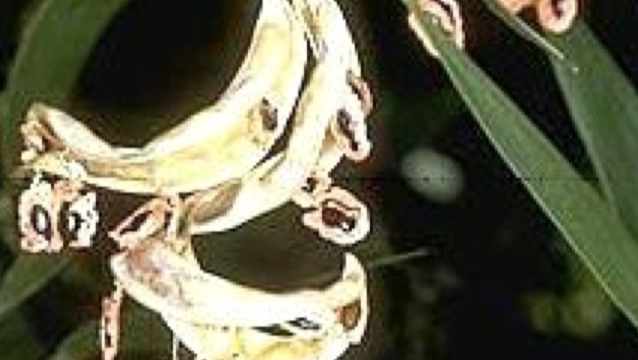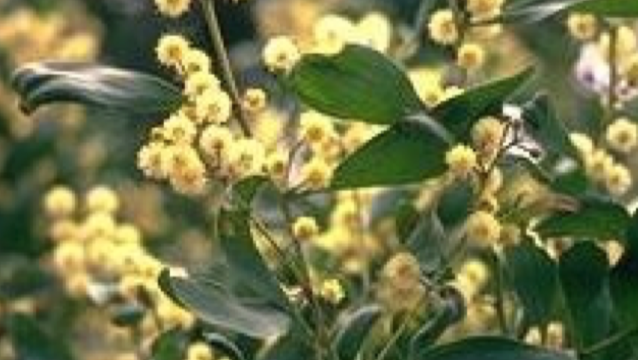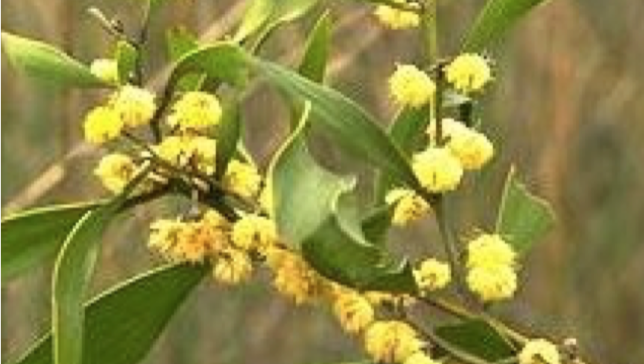

ANBG Photo No.: a.6987)

Credit: World Agro Forestry
Local names: Amharic (omedla); Dutch (Australiese Swarthout); English (Tasmanian blackwood,swamp blackwood,blackwood acacia,blackwood,Australian blackwood); French (acacia a bois noir); German (Schwarzholz Akazie); Italian (acacia nera australiana); Spanish (Aromo negro)
Botanic Description: Acacia melanoxylon is a tree 6-45 m tall, 1.8 m in girth, with an erect bole up to 25 m, usually branching a short distance from the ground; crown dense, of characteristic shape; branchlets smooth or densely hairy, angular, soon becoming round and downy; bark dark grey, rough, longitudinally and transversely furrowed.
Foliage olive green or grey-green, consisting of phyllodes 4-16 x 6-25 mm, glabrous, with 3-5 main longitudinal nerves, main nerves anastomosing to form a netlike reticulum, ending in a small, blunt point and tapering at the base into a short, thick stalk; gland 1-10 mm from base; leaves found only in juvenile stage; juvenile foliage with feathery leaflets.
Inflorescence mostly 3-5 headed racemes, 6-40 mm long, of 3-5 (max. 8) flowers, shorter than phyllodes; flowers creamy white, in small, round heads; peduncles branched, 4.5-13 mm long.
Pods flat, red-brown, smooth, curved, openly coiled or twisted, 3-15 cm long, 3.5-8 (max. 10) mm wide, leathery to subwoody, irregularly and very slightly constricted between seeds, with thickened margins; seeds shiny, black, oval, longitudinal in pod; stalk long, conspicuous, crinkled, flattened, orange-red or pink, almost completely encircling the seed in a double fold.
The generic name ‘acacia’ comes from the Greek word ‘akis’, meaning ‘point’ or ‘barb’. The specific name is derived from Greek ‘melanos’-black and ‘xylon’-wood.
Biology: Flowering is variable throughout the species range. In the northern part of Australia, flowering tends to be in the late winter-spring while in the southern part, in the spring-summer. Ripe seeds are available in the summer-autumn with mid-February peak and little seed is retained on branches beyond April. Insects pollinate the flowers.
Ecology: A. melanoxylon withstands frost. It grows in cool, temperate rainforests, open forests of the tablelands and coastal escarpments. It performs well in transitional to wet montane habitats.
Biophysical Limits: Altitude: 1500-2300 m, Mean annual temperature: 6-19 deg. C, Mean annual rainfall: 750-2300 mm
Soil type: A. melanoxylon grows best in rich, saline, deep, fertile loams, forest Podsols and alluvials. It also grows on a wide range of Podsols, krasnozems, sandy loams and alluvials and will also tolerate wet, nearly swampy soil.
Documented species distribution: Native: Australia
Exotic:Albania, Eritrea, Ethiopia, Greece, India, Italy, Kenya, Malta, Papua New Guinea, Portugal, South Africa, Spain, Sri Lanka, Tanzania, Uruguay
Products:
Fodder: The leaves can supply about 50-80% dry matter requirement of livestock.
Fuel: A. melanoxylon is a good source of firewood and charcoal.
Timber: The moderately heavy, light to dark brown, strong wood that is moderately resistant to termites is used for railway coaches, cabinet work, furniture, boat building, bear casks, plywood and tennis racquets.
Poison: The wood contains acamelin and 2,6-dimethoxyl-4 benzoquinone that cause may allergic contact dermatitis and bronchial asthma in people working with the wood.
Services: Erosion control: A. melanoxylon is planted on denuded hilltops to stabilize them.
Reclamation: A. melanoxylon grows well on residue from tin sluicing operations. Shade or shelter: The tree casts a useful shade and acts as a windbreak.
Nitrogen fixing: A. melanoxylon is nodulated; nodules on seedlings are light coloured, round and smooth; those on mature trees are multi-lobed, dark brown and wrinkled with a corky to woody surface.
Ornamental: The beautiful tree may be planted in amenity areas.
Tree Management: Growth of trees can be slow up to the height 2 m due to browsing by cattle, after which growth becomes rapid at 60 cm/year. The tree attains the height of 20 m in 30 years and coppices feebly. A mature tree 20 m tall can be lopped twice a year and will yield 100 kg of fodder per lopping.
Germplasm Management: After extraction and cleaning, the seeds can be dried in the sun before storing to a moisture content of 5-9%. Seed storage behaviour is orthodox; 12% germination following 51 years of open storage at room temperature. Viability is maintained for at least 20 years in open storage at room temperature and can be maintained for several years in hermetic storage at 10 deg. C with 5-9% mc. Mature and properly dried seeds can be stored in airtight containers at room temperature for at least 1 year, and at 10 deg. C for several years. On average, there are 64 000 seeds/kg.
Pests and Diseases: Acacia melanoxylon trees are highly susceptible to attack by Lorantheceous parasites and the fungus Armillaria mellea. Seedlings are browsed by cattle.
Sources:
Orwa C, A Mutua, Kindt R , Jamnadass R, S Anthony. 2009 Agroforestree Database:a tree reference and selection guide version 4.0 (http://www.worldagroforestry.org/sites/treedbs/treedatabases.asp)